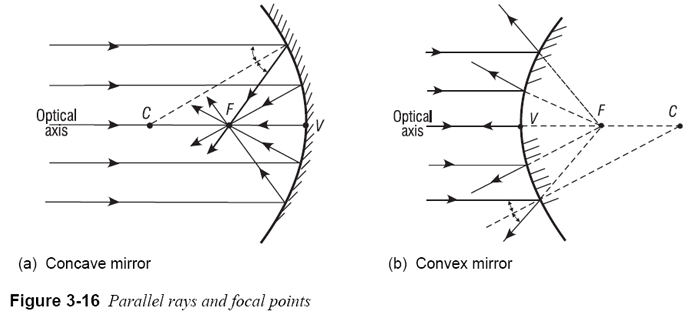
(a) Concave mirror surface (b) Convex mirror surface
The edges of concave mirrors always bend toward the oncoming light. Such mirrors have their center of curvature C and focal point F located to the left of the vertex as seen in Figure 3-15a. The edges of convex mirrors always bend away from the oncoming light, and their center of curvature C and focal point F are located to the right of the vertex. See Figure 3-15b.
The important connection between parallel rays and the focal points for mirror surfaces is shown in Figure 3-16 a, b. Parallel rays are light rays coming from a very distant source (such as the sun) or from a collimated laser beam. The law of reflection, applied at each point on the mirror surface where a ray is incident, requires that the ray be reflected so as to pass through a focal point F in front of the mirror (Figure 3-16a) or be reflected to appear to come from a focal point F behind the mirror (Figure 3-16b). Notice that a line drawn from the center of curvature C to any point on the mirror is a normal line and thus bisects the angle between the incident and reflected rays. As long as the transverse dimension of the mirror is not too large, simple geometry shows that the point F, for either mirror, is located at the midpoint between C and F, so that the distance FV is one-half the radius of curvature CV. The distance FV is called the focal length and is commonly labeled as f. 
Page: 12345678910111213141516171819202122232425262728293031323334353637383940
| Eyes carePhysicianBate's booksTechnologyForumLaser corre.Blues under eyesburning in the eyesanother diseasesMedical mistery Naturally eyesight correction. No laser eye surgery. Restore eyesight. Vision correction. |




